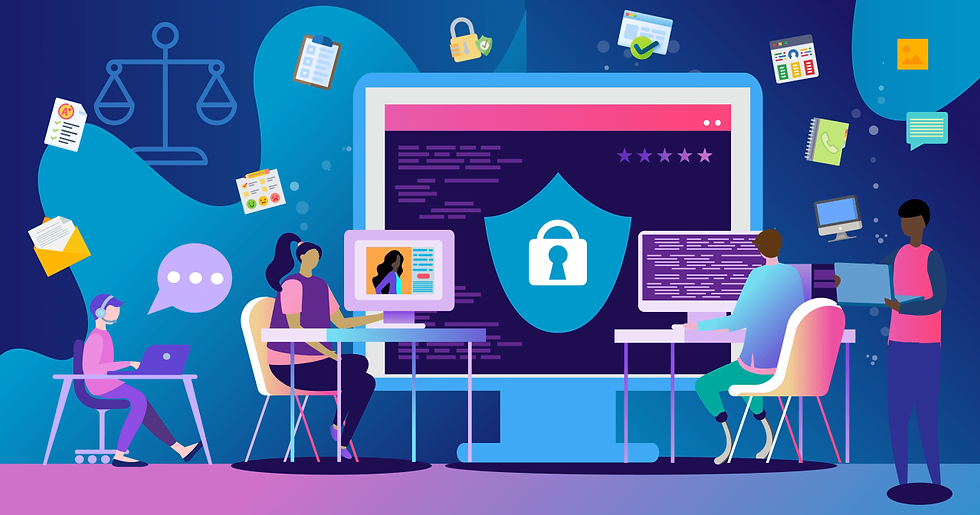Beyond Phishing: Emerging Cyber Threats
- Khushbu Raval
- Aug 16, 2024
- 3 min read
Updated: Oct 29, 2024
Discover the latest cyber threats, such as supply chain attacks, open-source vulnerabilities, and AI risks, and learn how to protect your organization from these evolving dangers.

As cyber threats evolve, so too does the cybersecurity landscape. Once dominated by familiar threats like phishing and ransomware, we now face increasingly sophisticated attacks targeting the very core of our digital infrastructure.
This post delves into emerging threats such as supply chain risks, open-source software vulnerabilities, and the complexities of integrating generative AI. We’ll also outline strategic defence tactics to help organisations stay ahead.
Supply Chain Cyber Risks
Recent supply chain attacks have underscored the devastating potential of this threat vector. A prime example is the XZ Utils backdoor (CVE-2024-3094), a critical vulnerability embedded in a widely used open-source compression tool. This multi-year attack highlights the ability of malicious actors to infiltrate and exploit foundational software across numerous organisations.
To mitigate these risks, organisations must prioritise the security of their software supply chain. Open-source components, often maintained by small teams, can be particularly vulnerable. Regular monitoring for updates and patches is essential to prevent the introduction of new vulnerabilities.
Open-Source Software Issues
The XZ Utils incident underscores the broader risks within the open-source ecosystem. Malicious actors can easily infiltrate open-source projects, as demonstrated by the "Jia Tan" account, which covertly inserted malicious code into widely used software. Even the Python package manager, PIP, has been compromised, raising concerns about the security of countless critical Python packages.
These incidents highlight the urgent need for increased vigilance and verification within the open-source community. Organisations must implement rigorous vetting processes and utilise tools to monitor suspicious activity within their codebases.
The Promise and Perils of GenAI
Generative AI (GenAI) is revolutionising industries. Klarna’s AI assistant exemplifies its potential, handling the workload of 700 agents and generating $40 million in annual savings. However, integrating GenAI carries risks like data poisoning, denial-of-service attacks, and privacy breaches.
To mitigate these, focus on availability, system integrity, and privacy. These are essential for deploying GenAI at scale.
Best Strategic Defence Tactics against Cyberattacks
Organisations must adopt a multi-layered defence strategy to navigate this complex threat landscape. Here are some critical components:
Proactive security testing, such as red and blue team exercises, is crucial. These simulations mimic real-world cyberattacks, uncovering vulnerabilities before exploitation. For AI systems, these exercises should focus on assessing model robustness against threats like hallucinations, bias, and harmful content. Continuous evaluation and improvement are essential for maintaining AI security and ethical performance.
AI-specific security measures are crucial as AI integration grows. Leveraging resources like ATLAS, a knowledge base complementary to MITRE ATT&CK, can help. ATLAS documents real-world adversarial tactics against AI systems. Organisations should use ATLAS to stay informed about evolving threats and strengthen defences against AI-targeted attacks.
Adopting a zero-trust architecture is essential in today's threat landscape, especially for AI-integrated systems. This approach assumes no one or thing can be trusted by default, requiring continuous identity verification and strict access controls. Data protection is paramount for AI systems. AI models often process sensitive data, necessitating clear boundaries to prevent unauthorised access and maintain data integrity. Organisations can safeguard their AI systems and the valuable insights they generate by combining zero-trust principles with robust data protection.
Conclusion
The evolving threat landscape demands a proactive and vigilant approach to cybersecurity. Organisations must understand the risks posed by supply chain vulnerabilities, open-source software, and generative AI to protect their digital assets effectively. Cybersecurity should be a strategic imperative, integrated across the entire organisation, rather than solely an IT concern.
Want to learn more about emerging threats and vulnerabilities? Attend the Digital Identity Innovation Summit in Amsterdam on 24-25 April 2025.


